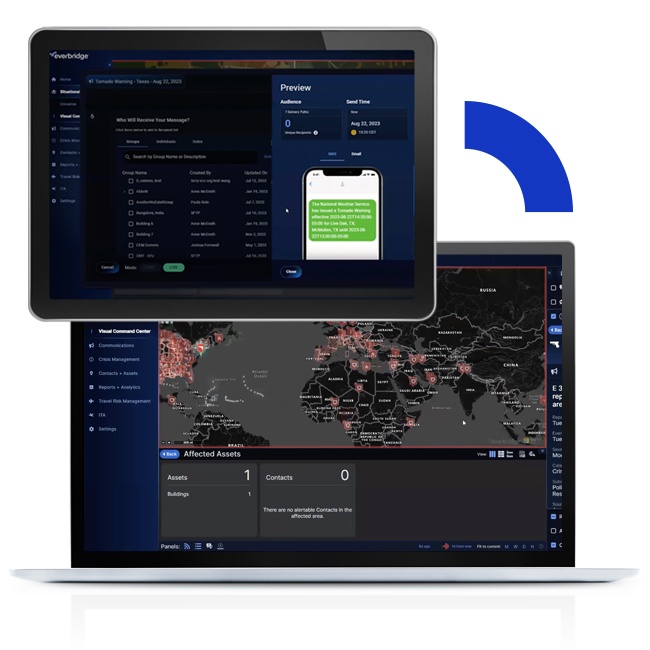Financial services industry solutions
The financial services industry faces major regulatory and stakeholder pressure to deliver operational resilience. This is inherently a challenge given the complexity of processes, technology infrastructure, and organizational silos.
Financial institutions must mitigate the threat of systemic risks and ensure regulatory compliance. Enhance preparedness, operationalize risk management, and resilience through the standardization and automation of threat detection, crisis management, incident response, emergency communications, and reporting. This approach should be integrated across siloed operational groups to bolster operational resilience and responses to business-impacting events.

When time is money, seconds matter.
Significant operational failures in a financial services organization can cause wide-scale disruption and potential systemic failures that affect national or international populations. Operational disruption can be caused by technology failures, cybersecurity incidents, natural disasters, terrorism, criminal acts, civil unrest, climate risk and severe weather, geopolitical dangers and economic threats.
A stronger focus on regulation
An operational resilience framework is a far-reaching and complex endeavor, and whilst some firms are already in implementation, a large portion of the sector have yet to start.
Financial Services operational resilience regulation often requires an institution to absorb shocks and continue to deliver critical operations, whether directly or through a third party, during any type of disruption.
Operational resilience is no longer a ‘nice to have’, it’s a regulatory requirement in many jurisdictions around the world. Some examples, but not all, are given below:
US the Securities and Exchange Commission (SEC)
The US Securities and Exchange Commission (SEC) Division of Examinations highlighted operational resilience as important. The Board of Governors of the Federal Reserve System, along with the Federal Deposit Insurance Corporation (FDIC) and the Office of the Comptroller of the Currency (OCC), issued an interagency paper titled Sound Practices to Strengthen Operational Resilience.
Also in the US, The FFIEC (Federal Financial Institutions Examination Council) has enhanced their mandates for operational resilience, business continuity and crisis management for the financial sector. Rising expectations from regulators demonstrate the need for a single, unified critical event management platform to be used across operational risk areas to gain efficiencies of process, knowledge, and impact assessment. Regulators are focused on the impacts of operational outages and the affect they can have across the industry. Regulators are asking for response benchmarks, detailed tracking, audit logs and evidence of executive oversights.
The European Union (EU)
The European Union (EU) introduced the Digital Operational Resilience Act (DORA).
United Kingdom (UK)
The United Kingdom (UK) issued the Operational Resilience and Business Continuity framework through the Bank of England (BoE), the Financial Conduct Authority (FCA) and the Prudential Regulation Authority (PRA).
Australian Prudential Regulation Authority (APRA)
The Australian Prudential Regulation Authority (APRA) introduced standards to strengthen financial resilience for regulated entities.
Hong Kong Monetary Authority (HKMA)
The Hong Kong Monetary Authority (HKMA) introduced the Digital Operational Resilience Act (DORA).
Monetary Authority of Singapore (MAS)
The Monetary Authority of Singapore (MAS) issued guidance on the importance of operational resilience.
Common challenges in Financial Services

Climate risk:
Several regulations and principles guide financial institutions to enhance resilience in relation to climate-related risks. The Bank of England (BoE) published the Climate Change Adaptation Report, addressing climate risks and regulatory capital frameworks for banks and insurers. US federal bank regulatory agencies finalized principles for safe and sound management of climate-related financial risks. The Australian Prudential Regulation Authority (APRA) requires entities to consider governance and risk management implications in relation to climate change. The European Central bank (ECB) Banking Supervision stresses that banks must meet supervisory expectations for climate-related risks or face potential penalties.

Cybersecurity preparedness:
Cybersecurity incidents pose a severe risk, as a single successful attack by hackers can lead to substantial reputational damage. Financial services organizations are particularly vulnerable, contending with an array of threats that include advanced phishing schemes, ransomware, third-party vulnerabilities, and internal security breaches.
Branch and data center threats:
Branches and data centers in the financial services sector are confronted with many risks spanning both physical and digital realms. These risks can be broad, affecting the entire enterprise, or specific to a particular location. They range from the unpredictability of severe weather and the sophistication of cyberattacks to the unpredictability of insider breaches, criminal activities, and civil disturbances. Additionally, the threat landscape includes targeted ATM attacks and the broader implications of climate change.
Digital transformation and technology outages:
Many financial institutions rely on outdated legacy systems that are often customized based on historic needs and manual processes and therefore do not integrate well with digital technologies. Outages can have significant impacts on customer trust and regulatory compliance.
Third-party service disruptions:
Financial services often depend on third-party providers for various services and technologies, and any disruption in these services can lead to outages.
Employee safety:
Employees face various risks in the workplace, when traveling, or working remotely; such as physical hazards, cyber threats, and operational errors. Financial services firms have a Duty of Care for employees. Prioritizing employee safety not only protects individuals but also contributes to financial services operational resilience and systemic trust.

Benefits
Respond better to business-impacting events and empower your operational resilience with the leading critical event management platform. Through the Everbridge platform, financial institutions will be able to adequately operationalize three key aspects of regulatory requirements;
- Preparedness,
- Automate communication and Response, and
- Reporting.
Everbridge has been recognized as a leader in the prestigious report The Forrester Wave™: Critical Event Management, Q4 2023. Forrester stated, “Everbridge provides a comprehensive platform that addresses all CEM use cases.”
A composite organization comprised of interviewees with experience using the CEM platform achieved a 358% ROI and US$8.5M in three-year risk-adjusted benefits, according to a commissioned Total Economic Impact(TM) Study by Forrester Consulting. This includes:
- $3M in efficiency gains
- $2M saved in reduced IT downtime
- $1.5M in security team productivity gains
Features
Everbridge 360™ combines risk intelligence, communication, collaboration, and coordination capabilities into a single platform, streamlining operations and elevating user experiences. It empowers organizations to efficiently handle incidents and emergencies, minimize communication time, and bolster overall organizational resilience. Everbridge helps organizations:
- Know earlier – through real-time threat intelligence
- Respond and recover faster – through automation
- Improve continuously -through data analysis
Equip your siloed operational risk groups with a common operating framework and response picture
In most financial institutions each operational risk group – cyber response, IT infrastructure, business continuity, service operations and security – uses different incident management parameters. Incident response is manual, and reporting is fragmented. Precious minutes are lost trying to contact and update employees and clients during critical events. Reliance on emails, unsecure messaging, and weak communications protocols are potential points of failure.
Everbridge enables financial services firms to standardize and automate threat detection, crisis management, incident response and emergency communications across their siloed operational risk groups. Their lines of business will have the agility, reliability, and efficiencies to manage a best-in-class operational resilience program.
Everbridge solutions play a key role in helping financial institutions to keep their people safe and their operations running.

Success stories

Santander saves time and cost with critical event management
Within a single platform, Santander can now coordinate all response activities, teams, and resources to accelerate recovery times and maintain command and control during a crisis.

Everbridge provides Public Service Credit Union (PSCU) with a flexible solution
Everbridge provides PSCU with a flexible, easy-to-use solution that can be quickly scaled depending on incident and event type. PSCU utilizes the system to keep employees safe and informed during weather related incidents, as well as routine events such as fire drills.

Customer video: Aon
Pale Mejia, Crisis Management Coordinator and Emergency Communications Manager for Aon, a leading global professional services firm, explains how the team leverages technology, like Everbridge, for employee safety and operational resilience. Aon provides a broad range of risk, reinsurance, retirement and health solutions.
Reach the highest level of resilience with BC in the Cloud (BCIC)
As the frequency and severity of incidents increase, financial services institutions need to reach new levels of readiness and become more agile when responding to regulator requests. BCIC was built to ensure financial services organizations can take their BC/DR programs beyond operational resilience to reach the highest standards of readiness.

Key advantages of BCIC for financial services
Enterprise-wide engagement
An effective resilience program cannot operate in a silo. We enable financial services institutions to inform and engage team members from across their organization–including executive leadership.
Fully integrated solution
BCIC gives financial services organizations the ability to plan, prepare, test, manage, and notify stakeholders about any potential business disruption.
Centralized response
Our solutions centralize all HR, facilities, customer, supply chain, and other business data into a comprehensive platform to increase visibility and facilitate unified responses.
Increasing efficiency, accuracy, and executive confidence
See what a global fintech firm was able to accomplish by selecting BCIC to improve and automate its business continuity program.
Resources
Featured

eBook: The ultimate operational resilience handbook (Intl.)
A practical guide for risk professionals to manage the multiple dimensions of operational resilience.
Regulations
Blog: Understanding DORA: How to operationalize digital resilience
Webinar: Ensuring business continuity: How to use regulatory frameworks to your advantage
Webinar: Unlocking DORA, from policy to operationalization
Everbridge for EU regulations: NIS2, DORA, Cyber Resilience Act
DORA FAQ for financial institutions
Best practices
Webinar: The roadmap to true organizational resilience: Best practices for success